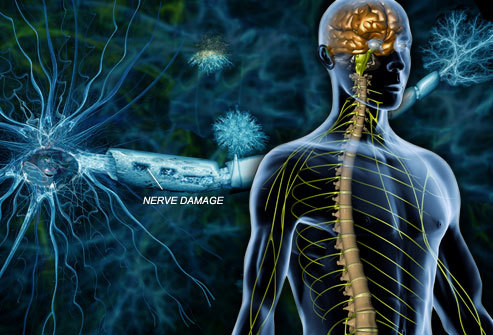#humanactions
What causes multiple sclerosis?
While the cause (etiology) of MS is still not known, scientists believe that a combination of several factors may be involved. Studies are ongoing in the areas of immunology (the science of the body’s immune system), epidemiology (that looks at patterns of disease in the population), and genetics in an effort to answer this important question. Understanding what causes MS will be an important step toward finding more effective ways to treat it and—ultimately—cure it, or even prevent it from occurring in the first place.
The major scientific theories about the causes of MS include the following:
Immunologic
It is now generally accepted that MS involves an immune-mediated process—an abnormal response of the body’s immune system that is directed against the myelin (the fatty sheath that surrounds and insulates the nerve fibers) in the central nervous system (CNS—the brain, spinal cord and optic nerves). The exact antigen, or target that the immune cells are sensitized to attack, remains unknown — which is why MS is considered by most experts to be immune-mediated rather than autoimmune. In recent years, however, researchers have been able to identify which immune cells are mounting the attack, some of the factors that cause them to attack, and some of the sites, or receptors, on the attacking cells that appear to be attracted to the myelin to begin the destructive process. Ongoing efforts to learn more about the immune-mediated process in MS—what sets it in motion, how it works, and how to slow or stop it—are bringing us closer to understanding the cause of MS.
Environmental
MS is known tooccur more frequently in areas that are farther from the equator. Epidemiologists—scientists who study disease patterns—are looking at many factors, including variations in geography, demographics (age, gender, and ethnic background), genetics, infectious causes, and migration patterns, in an effort to understand why. Studies of migration patterns have shown that people born in an area of the world with a high risk of MS who then move to an area with a lower risk before the age of 15, acquire the risk of their new area. Such data suggest that exposure to some environmental agent that occurs before puberty may predispose a person to develop MS later on.
Some scientists think the reason may have something to do with vitamin D (.pdf), which the human body produces naturally when the skin is exposed to sunlight. People who live closer to the equator are exposed to greater amounts of sunlight year-round. As a result, they tend to have higher levels of naturally-produced vitamin D, which is thought to have a beneficial impact on immune function and may help protect against autoimmune diseases like MS. The possible relationship between MS and sunlight exposure is currently being looked at in a Society-funded epidemiological study in Australia.
Other scientists study MS clusters—which are defined as higher-than-expected numbers of cases of MS that have occurred over a specific time period and/or in a certain area. These clusters are of interest because they may provide clues to environmental (such as environmental and industrial toxins, diet, or trace metal exposures) factors that might cause or trigger the disease. So far, cluster studies have not produced clear evidence for the existence of any triggering factor or factors in MS.
Infectious
Since initial exposure to numerous viruses, bacteria and other microbes occurs during childhood, and since viruses are well recognized as causes of demyelination and inflammation, it is possible that a virus or other infectious agent is the triggering factor in MS. More than a dozen viruses and bacteria, including measles, canine distemper, human herpes virus-6, Epstein-Barr, and Chlamydia pneumonia have been or are being investigated to determine if they are involved in the development of MS, but none have been definitively proven to trigger MS. Read more on viruses as the cause of MS
Genetic
While MS is not hereditary in a strict sense, having a first-degree relative such as a parent or sibling with MS increases an individual’s risk of developing the disease several-fold above the risk for the general population. Studies have shown that there is a higher prevalence of certain genes in populations with higher rates of MS. Common genetic factors have also been found in some families where there is more than one person with MS. Some researchers theorize that MS develops because a person is born with a genetic predisposition to react to some environmental agent that, upon exposure, triggers an autoimmune response. Sophisticated new techniques for identifying genes may help answer questions about the role of genes in the development of MS.
photo one source
photo two source
Post link
This was the state of space debris in 2008 according to the European Space Operations Centre. The amount of space debris has now become so large that it is threatening economically vital orbital regions.
Post link
Rosalind Franklin
1920 - 1958Rosalind Franklin always liked facts. She was logical and precise, and impatient with things that were otherwise. She decided to become a scientist when she was 15. She passed the examination for admission to Cambridge University in 1938, and it sparked a family crisis. Although her family was well-to-do and had a tradition of public service and philanthropy, her father disapproved of university education for women. He refused to pay. An aunt stepped in and said Franklin should go to school, and she would pay for it. Franklin’s mother also took her side until her father finally gave in.
…
She spent three years in France, enjoying the work atmosphere, the freedoms of peacetime, the French food and culture. But in 1950, she realized that if she wanted to make a scientific career in England, she had to go back. She was invited to King’s College in London to join a team of scientists studying living cells. The leader of the team assigned her to work on DNA with a graduate student. Franklin’s assumption was that it was her own project. The laboratory’s second-in-command, Maurice Wilkins, was on vacation at the time, and when he returned, their relationship was muddled. He assumed she was to assist his work; she assumed she’d be the only one working on DNA. They had powerful personality differences as well: Franklin direct, quick, decisive, and Wilkins shy, speculative, and passive. This would play a role in the coming years as the race unfolded to find the structure of DNA.
Franklin made marked advances in x-ray diffraction techniques with DNA. She adjusted her equipment to produce an extremely fine beam of x-rays. She extracted finer DNA fibers than ever before and arranged them in parallel bundles. And she studied the fibers’ reactions to humid conditions. All of these allowed her to discover crucial keys to DNA’s structure. Wilkins shared her data, without her knowledge, with James Watson and Francis Crick, at Cambridge University, and they pulled ahead in the race, ultimately publishing the proposed structure of DNA in March, 1953.
The strained relationship with Wilkins and other aspects of King’s College (the women scientists were not allowed to eat lunch in the common room where the men did, for example) led Franklin to seek another position. She headed her own research group at Birkbeck College in London. But the head of King’s let her go on the condition she would not work on DNA. Franklin returned to her studies of coal and also wrapped up her DNA work. She turned her attention to viruses, publishing 17 papers in five years. Her group’s findings laid the foundation for structural virology.
While on a professional visit to the United States, Franklin had episodes of pain that she soon learned were ovarian cancer. She continued working over the next two years, through three operations and experimental chemotherapy and a 10-month remission. She worked up until a few weeks before her death in 1958 at age 37.
Post link






